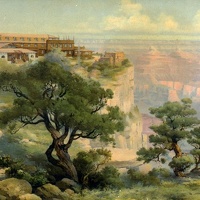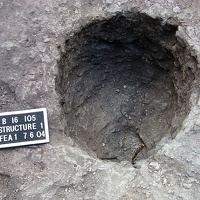This pit house on the South Rim of the Grand Canyon was home to perhaps four to nine people sometime in the early eleventh to mid-twelfth century (A.D. 1050-1130).
Residents of the house appear to have been of the Cohonina archaeological culture, based on ceramic artifacts, with ties to the Kayenta of northeastern Arizona, with whom they traded for decorated pottery, and perhaps the Hohokam to the south, through whom they may have acquired shell and obsidian.
The pit house contained a deep floor, a large hearth, and a thick roof, suggesting it was able to keep its residents warm even in the often harsh winter months experienced on the South Rim. The hearth certainly could have generated a large amount of heat for warmth and for cooking relatively large amounts of food.
Prior to abandonment of the site, the hearth was filled, the floor covered with sediment and small stones, and the pit house burned, likely by its residents, who took most of their belongings with them when leaving for a new location.
Reference:
Downum, Christian E. (2011) Archaeological Excavations at Site B:16:105, Grand Canyon National Park. Archaeological Report 1247. Northern Arizona University, Flagstaff.
- Author
- Anthropology Laboratories, Northern Arizona University
- File
- GRCARoll5.jpg
- File size
- 1253 KB

